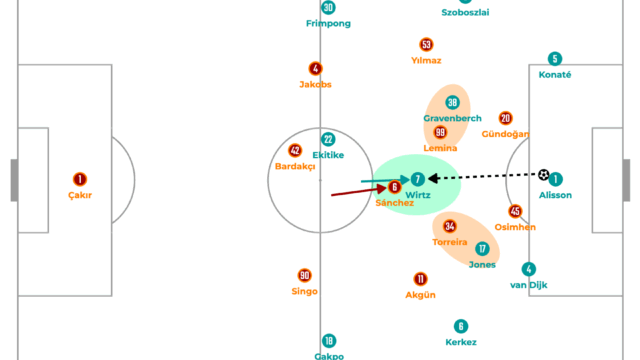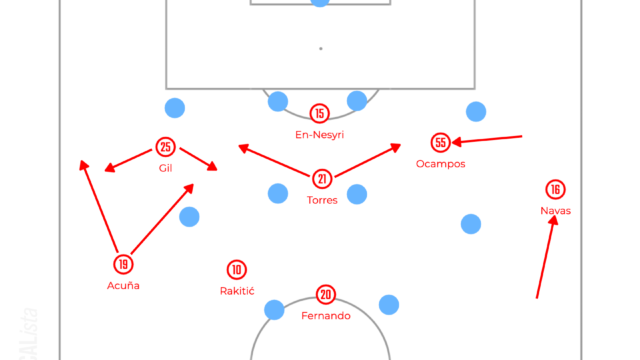Arne Slot’s Liverpool Tactical Analysis 25-26

In this article, the tactics of Liverpool under Arne Slot is going to be analysed based on their preseason games towards the 25-26 season.
In Possession
Build up
When they play out from the back, the basic structure is pretty similar to the trend in recent Premier League, which is a 4-4-2 with the wingers staying high to pin the opposition back line and two forwards dropping in between the lines. The illustration below shows their build up structure from a goal kick against Yokohama F Marinos in Japan.

The double pivots, Gravenberch and Szoboszlai stayed deeper to connect with the centre backs and the goalkeeper and Liverpool secured the 5v2 advantage to keep the ball at the back. The dropping forwards, Ekitike and Wirtz also helped to leave Gravenberch and Szoboszlai free by pinning the opposition defensive midfielders. Then, they hardly forced to go long, but they circulated the ball at the back to wait for the right moment to progress. In the example above, Van Dijk found Gravenberch to progress into the midfield.
When the opposition presses with a man to man approach, it will not be as easy as it was against Yokohama FM. In such situations, the defensive midfielders drop in between the centre backs to receive the ball away from the pressure.
The illustration below shows how Liverpool beat AC Milan’s man to man pressing.

Szoboszlai dropped into the back line to receive the ball from Alisson away from his marker. Then, Wirtz also came close to the ball, received it from Szoboszlai and played it to Salah who waited in between the lines.
This was a great example of how to keep the ball against man to man pressing. The opponents always come from behind you, so if you drop, they cannot reach. It was well played by Szaboszlai, and importantly Wirts as well.
His tendency to drop deeper to create an overload is a huge addition to Slot’s Liverpool in terms of playing out from the back more securely. Another example was found in the game against Yokohama FM.

When Kerkez possessed the ball, the nearest defensive midfielder Szoboszlai was marked by the opposition defensive midfielder and they seemed to be locked in. However, thanks to Wirtz dropping into the deep midfield, Liverpool successfully found a spare player to beat the opposition pressing.
And Wirtz’s ability is not only creating an overload at the back but also he can deliver the advantage forwards by carrying the ball by himself.

Like the example above, which is the moment just after the previous illustration, he played a quick one-two to create space for himself and carried the ball forwards and Liverpool were in the final third just a few seconds after being pressed in the defensive third.
In the midfield, they have a strong and aggressive intention to play forwards and the presence of Wirtz is already a key in their structure. Firstly, as this is their biggest strength, Liverpool have a strong intention to exploit the space in behind.

In the illustration above, it is easy to see their strong intention to play in behind as with only two passes, they quickly arrived in the box from the centre back. Van Dijk is able to play diagonal long balls and Szoboszlai can be a runner from the midfield.
Another example is illustrated below.

In the game against Preston North End, they played around in the midfield and quickly arrived in the box, again. Like the previous example, as soon as Salah received the ball, there were runners in behind. This time, the first runner was the right fullback Bradley, who was initially positioned in between the lines as the false fullback. Then, Szoboszlai made an underlapping run into the box as the second runner.
https://footballbunsekicom.com/tactics-analysis/profit-of-the-false-fullbacks-in-the-final-third/
The frequency of running in behind shows their strong intention to exploit the space in behind.
Secondly, they can not only play in behind, but also exploit the space in between the lines. The space there is extremely tight, but Wirtz made it look easy to play through the middle.

The example above, which was in the latest preseason game against Athletic, shows how they found Wirtz in between the lines. Endo found him after receiving the ball from Konaté and Wirtz laid it off to Szoboszlai.
Another example is here, against Milan.

Wirtz dropped a little bit next to the opposition defensive midfielder and received on the opposition midfield line. Then, he started to carry it forwards and generated the scoring opportunity by playing a through ball to Elliott.
As it was discussed before, the biggest strength of Wirtz is his ability to carry the ball forwards, not only just being able to play in a tight space. He has already shown what he can bring to the team and Liverpool became more secure in playing out from the back and dangerous to exploit not only the space in behind but also the tiny gaps in between the lines with him.
Final Third Attacking
In the final third, their main threat comes from flexibility. They constantly rotate their positions and do not stick to their fixed positions, which makes it difficult for the opponents to defend against. Even though they are flexible, there are a few rules which prevent them from being chaotic. The main principle is the triangles in wide areas.

The illustration above shows the second goal against Athletic in the match 1.
Firstly, when the right winger Doak received the ball, the right fullback Stephenson made an underlapping run from the inside position. Then, the movement dragged the opposition defensive midfielder, which vacated the space for Elliott. Doak played the one-two with him to penetrate into the box to deliver the cross which produced the goal.
Another example is shown below.

This is the same situation as Elliot made a run through the channel which left the space for Wirtz inside. The key takeaway is the difference of their positions. In the first example, the right fullback made the underlapping movement but this time it was Elliott who played as the 10. This means that it is not the fixed positions to perform the movements, but it is just where they are, which enables them to leave their positions frequently without being stuck.
After finding a player in the middle through the triangle combinations, they can exploit the space in front of the opposition back line as well.

This illustration shows the example of exploiting the space in the middle after the triangle. Gravenberch received the ball as usual and he dragged the opposition defensive midfielder out of his position. Then, the space in the middle opened up and Wirtz received the ball in the huge area to take a shot.
This flexibility is based on their strong intention to go forwards. In wide areas, there must be a runner through the channel, which is the trigger of the triangle. Then, the defensive midfielder or fullback steps up to exploit the space vacated by the first runner who drags the opponent away. However, this weakens the security against the opposition counterattacks.
Actually, it happened against AC Milan.

As both defensive midfielders were away from their original positions, there was space for the opponents. Pulisic could face forwards and played in behind, then Leão got past the centre backs to score.
Of course, Leão is a special player in this kind of transitional situation and this time it was Gravenberch who played as the right centre back. If it were another usual centre back like Konaté, this weakness would have been concealed, although this is a weakness of Slot’s strategy.
Overall, their flexibility is the biggest threat in the final third, as their strong intent to exploit the space in behind and Wirtz’s ability to flourish in the middle are difficult to stop. On the other hand, as most players do not hesitate to step higher, the defence against the opposition counterattacks hugely relies on the individual ability of the centre backs.
Out of Possession
Pressing
Their pressing, driven by high intensity has been already working in the preseason. Especially against the opposition goal kicks, they match their system to press man to man. Let’s look at some examples.

The illustration above shows how they pressed against Milan’s goal kick. As soon as the left centre back played back to the goalkeeper, Wirtz started to press on the goalkeeper from the opposite side from where the goalkeeper received the first pass. This forced the goalkeeper to play long and Van Dijk won the ball back.
Against Athletic, Ekitike did the same job to let the goalkeeper launch the ball, which was won back by Endo.

The man to man approach requires each player to have an individual advantage against each opponent and Liverpool have that. In addition to this, their high intensity pressing robs time from the opponents to think, which can force them to make errors.
To make it man to man, Liverpool sometimes need to adjust their shape asymmetrically. The frequent pattern is Salah stepping higher. Salah staying high can reduce his defensive tasks and increase threats when playing counterattacks.
Then, the problem is how to cover the space behind Salah.

The example above shows how Gravenberch covered the space behind Salah. As his range to defend is huge, it is possible for Liverpool to nullify the space for the opponents behind Salah.
However, this can be beaten by the opponents and let’s have a look at this in the next chapter.
Final Third Defending
They hardly defended deep, so when they needed to defend in their defensive third was when their pressing did not work. When they conceded the goal against Yokohama FM, their pressing was beaten and they could not retreat well to recover from the error.

As it was discussed earlier, Salah applied pressure on the opposition centre back, so the right fullback Bradley needed to step up to press on the opposition left fullback. However, it was delayed and the opposition could beat the pressing. Even worse, Konaté was also dragged out by the opposition left winger, so the gap between the centre backs opened up, which could not be recovered even in the final third.

Wirtz and Bradley were too late to drop into the back line to protect the space between Konaté and Van Dijk, which was exploited by Yokohama FM.
This is similar to their management against the opposition counterattacks. They, not only Liverpool but also other big clubs in Europe, hugely rely on the ability of the centre backs to stop the danger at the last moment. In terms of this, Liverpool might lack the depth of the centre backs, so this can be only their concern towards this season.


